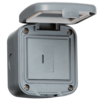Would appreciate guidance/advice on suitable amp rating for a cable I wish to use to wire an external PIR and an associated 20W LED light.
Normally, I wouldn't need to ask such a simple question but I'm a bit unsure about my house wiring and think it may affect the current rating of wiring I should use. I have wired several external PIR LED lights and LED + PIR combinations before but always used an individual 3 amp fused spur for each light and used cable rated at 6 amps.
An extension was built a few years ago and I've never taken the trouble to fully understand the new wiring circuits - until a combined LED/PIR unit (added when the extension was built) failed the other day. I intend to replace the combined unit with a separate PIR and an LED light. I discovered that the 13 amp fused spur I thought was solely for the PIR/LED light actually supplied my garage too. The fused spur is on the circuit (maybe ring main, maybe radial) that supplies kitchen and utility room sockets and is protected by a 32A MCB in the distribution box. I've removed the failed PIR/LED light, and associated wiring, which just leaves the external junction box, with its mains supply, ready for re-wiring the new PIR and separate LED light.
Question is: should I use 13+ amp rated cable to wire the PIR and LED light because of the 13 amp fused spur that feeds it? I can't down-rate the fuse in this spur as I need it to be 13 amps for the garage sockets. Thanks for your time.
Normally, I wouldn't need to ask such a simple question but I'm a bit unsure about my house wiring and think it may affect the current rating of wiring I should use. I have wired several external PIR LED lights and LED + PIR combinations before but always used an individual 3 amp fused spur for each light and used cable rated at 6 amps.
An extension was built a few years ago and I've never taken the trouble to fully understand the new wiring circuits - until a combined LED/PIR unit (added when the extension was built) failed the other day. I intend to replace the combined unit with a separate PIR and an LED light. I discovered that the 13 amp fused spur I thought was solely for the PIR/LED light actually supplied my garage too. The fused spur is on the circuit (maybe ring main, maybe radial) that supplies kitchen and utility room sockets and is protected by a 32A MCB in the distribution box. I've removed the failed PIR/LED light, and associated wiring, which just leaves the external junction box, with its mains supply, ready for re-wiring the new PIR and separate LED light.
Question is: should I use 13+ amp rated cable to wire the PIR and LED light because of the 13 amp fused spur that feeds it? I can't down-rate the fuse in this spur as I need it to be 13 amps for the garage sockets. Thanks for your time.




